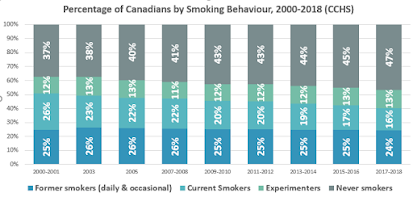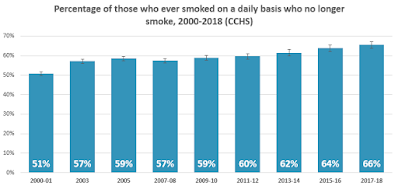Shortly after Statistics Canada released data from the 2017-2018 Canadian Community Health Survey (CCHS), we reported on the relatively small contribution of quitting to the progress against tobacco use, focusing on population growth and turn-over (deaths) over the past decade.
This post takes a second look at changes in quitting behaviour over the past 20 years for Canadian men and women at different stages of life. It identifies some of the challenges in using quitting rates or quit ratios as indicators for tobacco control.
The percentage of Canadians who are former smokers has barely changed since the beginning of the century....
Although the proportion of Canadians who smoke has fallen from one-quarter (26%) in 2000 to one-sixth (16%) in 2018, the share of the population who are former smokers has barely budged - hovering around 25%. As discussed earlier this summer, and shown below it is the growth in "never smokers" that has driven overall smoking rates down.
Between 2000 and 20018, the number of smokers fell by 1.7 million, but the number of former smokers grew by only 1.2 million. The number of people who had never smoked one cigarette grew by 5 million.
The slow growth in the number of former smokers can mask progress in the proportion of smokers (instead of the proportion of the whole community) that have stopped smoking.
Looking at the number of Canadians who have quit smoking as a proportion of those who have ever smoked shows that there has been overall growth in quitting.
The daily smoker Quit Ratio (ratio of former daily smokers to ever daily smokers) has grown from half (51%) in 2000 to two-thirds (66%) in 2018 (shown below). The current smoker Quit Ratio, which includes those who continue to smoke on an occasional basis, has grown somewhat less (from 49% to 61%). The figure is available on the downloadable Excel sheet, linked below.
Success in quitting comes with age...
Although virtually all smokers start before they are in their early 20s, successful quitting happens at all ages and accumulates as people age. This is illustrated in the chart below, which shows the percentage of ever smokers who have quit in 5 age groups over 2000 to 2018, the years of available CCHS data.
The proportion of former smokers is particularly high for those over 65, in part because of the early death of smokers. Those in the numerator live longer than those in the denominator! (The median age of dying of a tobacco-related disease is in the early 70s.)
... which means an aging population will have more successful quitters
The increased proportion of smokers who have quit may be the result of the natural aging of Canada's population. Canada's population is aging: the median age of Canadians grew from 36.8 to 40.8 between 2000 and 2018. The proportion of Canadians participating in the CCHS who were 45 years or older grew from two-fifths in 2000 (42%) to one-half in 2018 (51%).
Definitions:
When talking about smoking, we frequently divide Canadians into three groups: those who smoke on a daily or occasional basis ('current smokers'), those who used smoke but who don't any more ('former smokers') and those who have never smoked ('never smokers'). The CCHS is such a large survey (around 100,000 respondents) that it allows for more distinctions to be made:
- Current smokers includes:
- Daily smokers - people who smoke on a daily basis.
- Occasional smokers - people who report that they smoke, but not every day.
- Former smokers:
- Former daily smokers are those who no longer smoke but who used to smoke every day.
- Former occasional smokers are those who used to smoke (but not daily) and who no longer do.
- Sometimes, this term has been used to include those non-smokers who have never smoked daily and who smoked very little (from 1 to 100 cigarettes in their life).
- Experimenters is the term now used to describe those who have smoked one cigarette in their life, but have never smoked more than 100 cigarettes and who do not smoke now.
- Never smokers (or abstainers) are those who have never smoked one whole cigarette.
Download the data!
Excel files for the tables presented above:- CCHS 2017-2018: Smoking behaviour and income, source of income and food insecurity (by age and sex)
- CCHS 2017-2018: Smoking behaviour and household income quintiles (by age, sex and province)
- CCHS 2005 to 2017-2018: Historic data - Smoking behaviour and household income quintiles .
- Demographic changes in smoking behaviour, 2007-2008 to 2017-2018.




